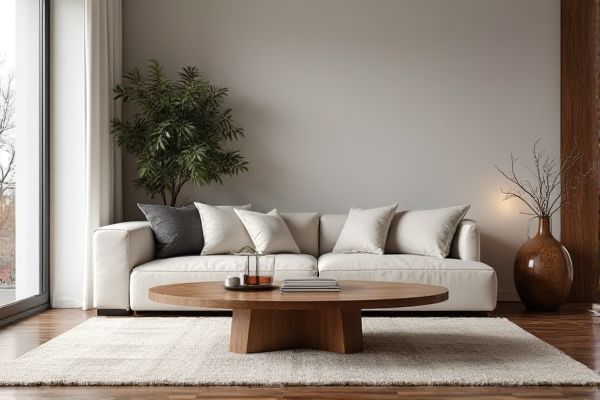
Square coffee tables offer ample surface area and a structured look that complements modern or minimalist interiors, while round coffee tables create a softer, more inviting atmosphere ideal for smaller spaces or homes with children. Explore this article to discover which coffee table shape best suits your living room style and functionality needs.
Table of Comparison
| Feature | Square Coffee Table | Round Coffee Table |
|---|---|---|
| Shape | Four equal sides with right angles | Circular without corners |
| Space Efficiency | Fits well in corners and compact spaces | Smoother flow in open or tight areas |
| Safety | Sharp edges may pose hazards | Rounded edges reduce injury risk |
| Seating Arrangement | Ideal for square or sectional sofas | Easy to access from all sides |
| Style | Structured and modern look | Soft, casual, and inviting |
| Surface Area | Usually offers more usable space | Limited surface area, but smooth shape aids movement |
Introduction: Square vs Round Coffee Tables
Square coffee tables offer a structured, geometric look that maximizes surface area and fits neatly into corners or alongside sectionals. Round coffee tables create a softer, more organic shape that enhances flow and reduces sharp edges, ideal for smaller spaces or homes with children. Your choice should consider room layout, safety preferences, and style to balance functionality and aesthetic appeal effectively.
Design Aesthetics: Shape and Style Comparison
Square coffee tables offer a structured, geometric aesthetic that complements modern and minimalist interiors with clean lines and defined edges. Round coffee tables provide a softer, more organic shape that enhances flow and promotes a sense of openness in small or casual living spaces. Choosing between square and round shapes depends on balancing visual weight, room layout, and desired stylistic impact to create harmony and functional appeal.
Space Utilization: Which Table Fits Better?
Square coffee tables optimize space in compact rooms by fitting snugly against walls or corners, maximizing usable floor area. Round coffee tables facilitate better flow in open layouts, preventing sharp edges and allowing easier movement around the furniture. The choice depends on room shape and traffic patterns, with square tables ideal for tight spaces and round tables enhancing spacious, circular seating arrangements.
Functionality: Practical Uses for Each Shape
Square coffee tables offer ample surface area and fit neatly against walls or in corners, making them ideal for maximizing space in smaller living rooms or for grouping multiple pieces together. Round coffee tables provide smooth, flowing edges that enhance safety and encourage easy movement around the furniture, perfect for homes with children or tight walkways. Your choice between square and round shapes should reflect how you prioritize surface space versus ease of movement in your living area.
Room Layout: Compatibility with Furniture Arrangement
Square coffee tables offer structured alignment that complements angular room layouts and sectional sofas, maximizing space efficiency in rectangular or square rooms. Round coffee tables enhance flow in open or circular seating arrangements by easing movement and reducing sharp edges, ideal for smaller or irregularly shaped spaces. Your choice depends on whether your room favors geometric precision or organic, curved furniture placement for optimal harmony.
Safety Considerations: Edges vs Curves
Square coffee tables often have sharp edges that may pose safety risks, especially in homes with children or pets, increasing the chances of bumps and injuries. Round coffee tables feature smooth curves that reduce these hazards by eliminating pointed corners, making them a safer choice for active living spaces. Choosing the right shape for Your coffee table can enhance safety without sacrificing style, depending on Your household's needs.
Storage Options: Built-in Features and Flexibility
Square coffee tables often provide enhanced storage options with built-in shelves or drawers, offering structured organization for magazines, remote controls, and other living room essentials. Round coffee tables typically feature open designs or removable trays, providing flexible storage that can adapt to various needs without cluttering your space. Your choice depends on whether you prioritize defined storage compartments or versatile, easy-access surfaces.
Material Choices: Square vs Round Table Trends
Square coffee tables often feature materials like wood, metal, and glass, catering to modern and industrial interior design trends. Round coffee tables commonly use wood, marble, and acrylic, aligning with contemporary and mid-century aesthetics. Material choices for square tables emphasize sharp lines and structured forms, while round tables highlight smooth curves and organic finishes.
Price Comparison: Budget and Value
Square coffee tables often provide more surface area at a lower price point, offering excellent value for budget-conscious shoppers. Round coffee tables typically carry higher price tags due to their design complexity and material usage, but they can add aesthetic appeal and better flow in smaller living spaces. Choosing between square and round coffee tables depends on prioritizing cost-efficiency versus style and spatial dynamics in your room layout.
Conclusion: Choosing the Right Coffee Table Shape
Square coffee tables provide a structured, modern look ideal for apartments or rooms with limited space, enhancing functionality with sharp corners for easy placement. Round coffee tables promote better flow and safety, perfect for families or areas where movement is frequent, as their curved edges reduce injury risk. Consider your room layout, lifestyle, and aesthetic preferences to choose the coffee table shape that best complements your living space and meets your practical needs.
 homyna.com
homyna.com